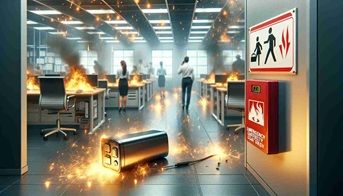Just 15% of organisations say they have conducted a workplace fire risk assessment to cover the risks posed by devices containing lithium-ion batteries, new research finds. Firechief Global urges organisations to get risk assessed for lithium-ion battery usage.
The data was gathered from over 500 organisations who were surveyed during webinars held by both IFSEC Insider and Firechief Global this autumn, and while 15% of respondents confirmed they had updated their fire risk assessments to cover the risk of LiB fires, 71% said they had not and a further 14% were unsure.
Lithium-ion batteries are now firmly part of daily life, both at home and in the workplace.
They are to be found in portable devices, electric vehicles, and renewable energy storage systems. Lithium-ion batteries have many advantages, but their safety depends on how they are manufactured, how they are used and stored and how they are recycled.
“A typical workplace is likely to have many devices containing Lithium-ion batteries” said Laurie Pollard, Managing Director of Firechief Global. “There will be mobile phones, laptops, e-bikes, e-scooters, and electric vehicles being used, stored, and charged on site and that’s before considering other equipment such as forklift trucks, power tools, and energy storage systems etc, so it makes sense to assess the fire risk these could pose should the worst happen, and then have an action plan in place to mitigate those risks.
“Clearly organisations will have many types of different risks given that there’s a huge variety of different lithium battery applications and integrations. Some lithium-ion battery risks are mobile, some are built into portal machinery, others are static.
“Sometimes it might be the handling of lithium-ion batteries that’s a risk. The batteries may be damaged, they may not; they may be brand new; they may be low in charge, they may potentially be highly charged. So, a strategy must be developed and created for the specific risk that is present”.








